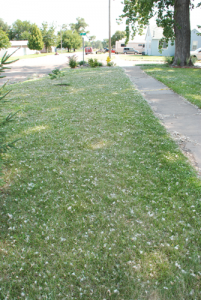Sitting in my platform rocker, looking out at the street with Bruce, my grandson. in my lap, I’m reminded of my grandmother, Hazel. She would also sit in her recliner watching the street from her own little house in town—two doors up from the Methodist Church. By the time she moved to town, her great-grandchildren were in middle and high school and they spent lots of nights in her back bedroom, especially those nights when blizzards tore through the plains.

Here in North Platte, in late July, I notice snow driven vertically across the window—big wet flakes of early, warmer-weather snow. Actually, it’s not the result of climate change I’m seeing. The snow is cottonwood seeds spreading throughout town. The man across the street told me my tree is the scourge of the neighborhood. I’m inclined to agree. All that cotton chokes the flower beds and whitens the lawn like a yard of dotted Swiss fabric. Even mild winds bring down twigs and clusters of leaves. I mow baby cottonwood trees every time I mow the lawn. I suppose my neighbors do too.
When I was a kid on the farm, though, I knew that cotton from trees volunteered in the windbreak would drift to the pond. It would float for the fish to suck off the surface. We didn’t have carp in our pond, but on those days we could get away and go to the lake we could watch carp vacuuming cottonwood cotton from the water in the bays.
I’ve tipi-camped in the Missouri Basin during February where the ancient cottonwood trees protect the campground. No cotton that time of year, but a thick, wool, Hudson Bay blanket kept our beds warm, even when fifty-below winds scoured the bluff tops above us.
Here in summer, despite the annoyance of cotton and twigs, the gigantic tree provides shade from morning sun. A spreading American elm takes over throughout the middle of the day. I frequently look at the tree and consider having it removed, especially now when I’m watching flurries of cotton. But I would miss the shade and the cost of cooling the unshaded house.